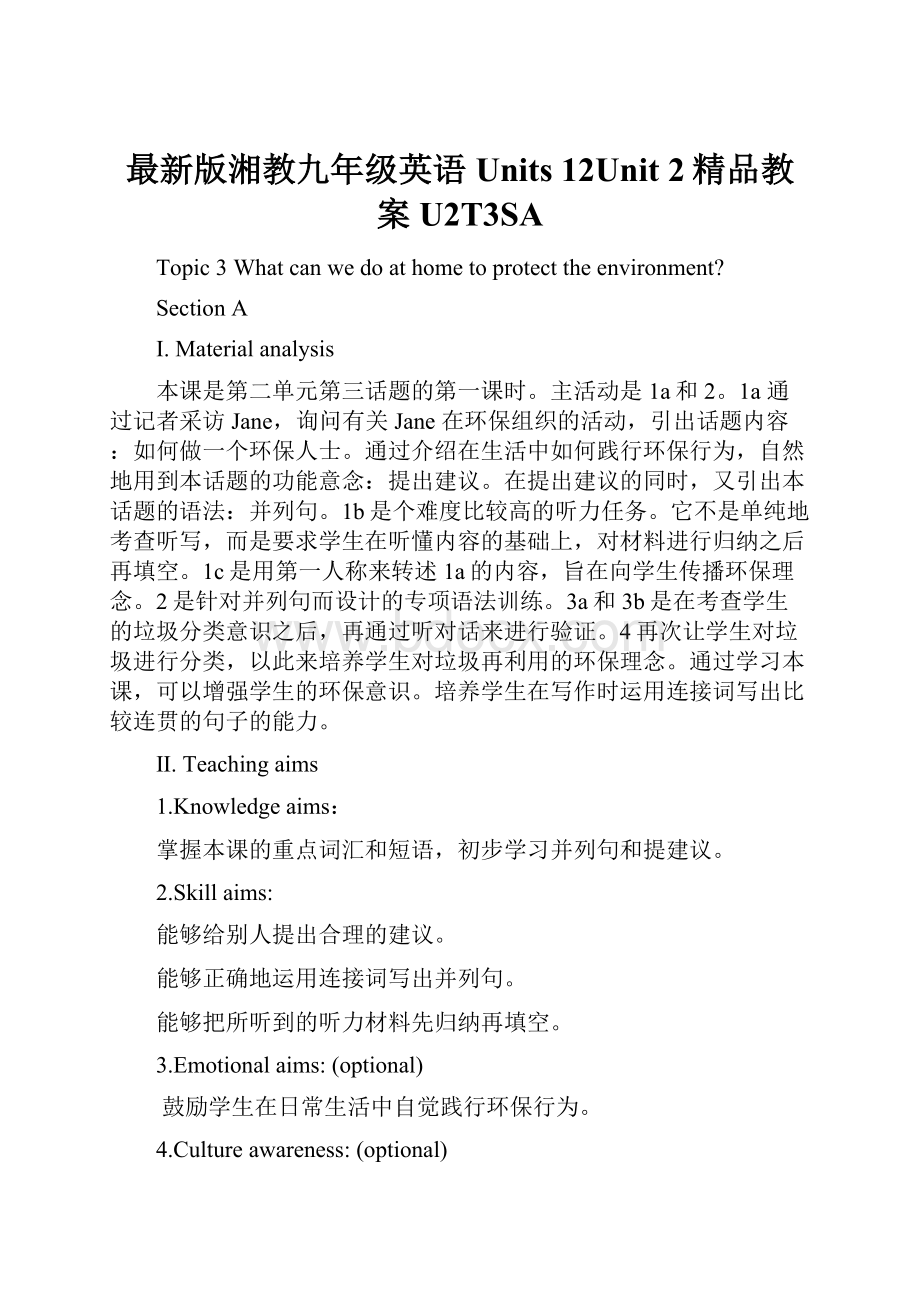最新版湘教九年级英语 Units 12Unit 2精品教案U2T3SA.docx
《最新版湘教九年级英语 Units 12Unit 2精品教案U2T3SA.docx》由会员分享,可在线阅读,更多相关《最新版湘教九年级英语 Units 12Unit 2精品教案U2T3SA.docx(19页珍藏版)》请在冰豆网上搜索。

最新版湘教九年级英语Units12Unit2精品教案U2T3SA
Topic3Whatcanwedoathometoprotecttheenvironment?
SectionA
Ⅰ.Materialanalysis
本课是第二单元第三话题的第一课时。
主活动是1a和2。
1a通过记者采访Jane,询问有关Jane在环保组织的活动,引出话题内容:
如何做一个环保人士。
通过介绍在生活中如何践行环保行为,自然地用到本话题的功能意念:
提出建议。
在提出建议的同时,又引出本话题的语法:
并列句。
1b是个难度比较高的听力任务。
它不是单纯地考查听写,而是要求学生在听懂内容的基础上,对材料进行归纳之后再填空。
1c是用第一人称来转述1a的内容,旨在向学生传播环保理念。
2是针对并列句而设计的专项语法训练。
3a和3b是在考查学生的垃圾分类意识之后,再通过听对话来进行验证。
4再次让学生对垃圾进行分类,以此来培养学生对垃圾再利用的环保理念。
通过学习本课,可以增强学生的环保意识。
培养学生在写作时运用连接词写出比较连贯的句子的能力。
Ⅱ.Teachingaims
1.Knowledgeaims:
掌握本课的重点词汇和短语,初步学习并列句和提建议。
2.Skillaims:
能够给别人提出合理的建议。
能够正确地运用连接词写出并列句。
能够把所听到的听力材料先归纳再填空。
3.Emotionalaims:
(optional)
鼓励学生在日常生活中自觉践行环保行为。
4.Cultureawareness:
(optional)
Ⅲ.Thekeypointsanddifficultpoints
1.Keypoints:
Wordsandphrases:
nod,agreement,disagreement,protection,organization,recycle,can,giveup,sothat,encouragesbtodosth.beharmfultosb./sth.
Sentences:
Weshouldreducethewasteweproduce.
Weshouldusebothsidesofpaperandreuseplasticbags.
It’sapleasure.
Recyclingcanprotecttheenvironment,anditcansavemoney,too.
Soweencouragestudentstocollectwastepaperandsoftdrinkcans.
Grammar:
compoundsentence
2.Difficultpoints:
根据句子需要,正确地选用连接词。
理解含有定语从句和情态动词被动语态的句子。
Ⅳ.Learningstrategies
在1b任务中,要先听懂对话内容,再归纳填空。
在2中,要明白不同的连接词的不同用法。
首先弄清上下句的关系,再确定用哪个连接词。
在3a中,要充分利用自己的生活经验和已有的知识。
Ⅴ.Teachingaids
教学新词的实物(如:
胶袋、电池、易拉罐等)/有环保标识的纸盒或瓶子/录音机/小黑板/PPT图片等。
Ⅵ.Teachingprocedures
Stage
(timeperiod)
Interaction
patterns
Teacheractivity
Studentactivity
Remarks
1
Gettingstudents
readyforlearning
(4mins)
Classactivity
PresentapictureofheavyhazeinBeijingandanalyzethecauseofit,learningsomeofthenewwords.
T:
Hi,class.Lookatthispicture.It’sBeijing.What’stheweatherlikethere?
T:
It’sneithercloudynorfoggy.It’shazy.Theword“haze”wasthemostfrequentlymentionedwordin2013inthemediainChina.EspeciallyinthebigcitiesinnorthernChina.Howdoyouthinkthehazecomesintobeing?
T:
Whatyousaidsoundsreasonable.Airpollutionplaysanimportantpart.Luckily,thegovernmentistakingmeasurestosolvethisseriousproblem,andmanyorganizationsaretakingpartintheenvironmentalprotection,too.Janeisworkingforsuchanorganization.
PresentapictureofheavyhazeinBeijingandanalysethecauseofit,learningsomeofthenewwords.
S1:
It’scloudy.
S2:
It’sfoggy.
S3:
Ithinkairpollutioncauseshaze.
S4:
Ithinktoomanycars.
S5:
Ithinktoomanyfactories.
学生没有学过hazy(有霾的),haze(霾),老师要用汉语标注一下。
学生弄懂以后才能展开后面的活动。
老师在点评时可以讲解:
protection,organization.最好用构词法来呈现:
protect(v)+tion=protection(n)
organize(v,组织)+tion=
organization(n)。
2
Lead-in
(4mins)
Classactivity
Presentsomerealobjectstolearnmorenewwordsandleadto1a.
T:
Perhapssomeofyouthinkit’sdifficultforstudentstodosomethingtoprotecttheenvironment.Infact,ifyoukeepdoingthreeR’sinyourdailylife,youwillbeagreenerperson.CouldyouguesswhatthethreeR’sreferto?
T:
Sorry,guessagain.
T:
Sorry,guessagain.
T:
Smartboy!
Youhavegotone.
T:
Wonderful!
Youhavegotanother.What’sthethirdone?
T:
Now,letmetellyou.It’s“recycle”.(Showthelogoofrecycling)Doyouoftenseethissignontheboxesorbottles?
T:
ThreeR’sareveryimportantinourlife.Forexample,weshouldreuseplasticbagsandrecyclebatteriesanddrinkcans.
Presentsomerealobjectstolearnmorenewwordsandleadto1a.
S1:
Refuse
S2:
Remember
S3:
Reuse.
S4:
Reduce.
S5:
..
Ss:
Yes.
老师在提到ThreeR’s时,应马上板书出来,并让学生猜是哪三个单词,借此讲解“re(再)+cycle(圆,环)=recycle(v).老师在讲解该词时可以出示循环使用的标志以帮助理解新词。
老师在展示实物时,应马上板书并讲解新词。
如:
plastic,battery,can.
3
Pre-listening
(2mins)
Individualwork
LettheSsreadthetablein1btogettoknowwhattheyshouldpayattentiontowhilelistening.
T:
Now,pleasereadthetablein1b.Thistime,thelisteningtaskisalittledifficult.Onlywhenyouunderstandthedialog,canyoucompletethetable.Sowhilelistening,youhadbetterpayattentiontothemaincontentofthedialog.
Readthetablein1btogettoknowwhattheyshouldpayattentiontowhilelistening.
1b的听写填空需要学生在完全理解对话的基础上完成,老师要提醒学生专注于听内容并要求学生在听前阅读1b,预测听力内容。
4
While-listening
(5mins)
Individualwork
LettheSslistento1aandfinish1b.Thenchecktheanswers.
T:
Now,ajournalistisinterviewingJane.Let’slistentowhattheyaretalkingabout.Afterlistening,completethetable.Whenyoufinish,putupyourhand.
T:
Whowouldliketoanswerthequestion?
Listento1aandfinish1b.Checktheanswers.
S1:
Organization,protecttheenvironment.
S2:
spreadthemessage
S3:
…
1b的听力任务难度有点大,可以让学生听两遍。
5
Post-listening
(10mins)
Individualwork
Classactivity
Classactivity
Step1:
LettheSsread1aanddo1c.Thenchecktheanswers.
T:
Wehavelistenedtotheinterview,andnowlet’sreadit.Pleasecompletethesentencesin1cwhilereading.Ifyoufinish,pleaseletmeknow.
T:
Shallwestartcheckingtheanswersnow?
T:
xxx,shallwestartfromyou?
Step2:
LettheSsread1aagaintofindthesentenceswhichgivesuggestions.
T:
Haveyoufoundthatinthisdialogmanysentencescontainsuggestions?
T:
Haveyoufoundsuchsentences,xxx?
T:
Weusuallyuse“should”togivesuggestions.Whocangiveusanexample?
Step3:
Dealwithlanguagepointsin1a.
T:
Mmm,goodexamples.Ihopeyouwillactasyousaid.Anyquestions?
Handsup!
T:
xxx,please.
T:
Goodquestion.Weknowthefirst“that”isanobjectclause,andthesecondoneisanewkindofgrammar.WewilllearnitinUnit4.It’scalled“attributiveclause”.Changeitinto“andit”,youwillunderstandthesentencebetter.WhocanputthissentenceintoChinese?
T:
Perfect!
Anymorequestions?
T:
Sure.“Sort”hereisaverb.Itmeans“divideaccordingtodifferentkinds”.“Canberecycled”isalsoakindofgrammar.It’scalledpassivevoice.Becausethewastecan’trecyclebyitself.It’speoplewhorecycleit.InChinese,thewholesentenceis“然后,我们把它们进行分类以便它们能被回收再利用。
”
Read1aandfinish1c.
Ss:
Sure.
S1:
Reduce,reuse,recycle
S2:
Sides,plastic
S3:
…
Read1aagaintofindthesentenceswhichgivesuggestions.
Ss:
Yes.
S1:
Weshouldreducethewasteweproduce.
S2:
Weshouldusebothsidesofpaperandreuseplasticbags.
S3:
…
S4:
Weshouldlistentotheteachercarefullyinclass.
S5:
Weshouldkeeptheclassroomclean.
S6:
Weshouldn’twastewater.
Step3:
Read1aagainandaskquestionsaboutsomedifficultpoints.
S1:
Howtounderstandthesecond“that”in“Weallknowthatyou…thatenvironment”?
S2:
我们都知道你在一个保护环境的组织里工作。
S3:
Couldyouexplain“Thenwesortthemsothattheycanberecycled”?
对于本课出现的定语从句和情态动词的被动语态,老师只要让学生理解句子意思即可,不要求深度解释。
为了让学生便于理解,老师可以简单地用“把”字句和“被”字句来解释被动语态。
6
Finishing
Task2
(13mins)
Classactivity
Classactivity
Individualwork
Step1:
PresentthefollowingsentencesonthesmallBboronthescreen.LettheSsunderstandtheunderlinedwordstolearnconjunctions.
Sentences:
Sowhatcanwedoathometoprotecttheenvironment?
Recyclingcanprotecttheenvironment,anditcansavemoney,too.
Soweencouragestudentstocollectwastepaperand
softdrinkcans.
T:
PleaselookatthesentencesontheBbandunderstandtheunderlinedparts.Whatdowecalltheunderlinedwords?
T:
Whocantellmesomemoreconjunctions?
T:
Besidesthese,Icannamemoreconjunctions,suchas:
for,as,since,etc.Andweusuallyuseconjunctionstomakecompoundsentences.Forexample:
Hurryup,oryouwillbelateforschool.
ZhangHonglikesapples,butIdon’tlikeapplesatall.
HuangRongisgoodatmathwhilehertwinsisterisgoodatEnglish.
Thiscoatlooksniceandit’scheap,too.
Step2:
Letonestudentcometothefronttoperformtolearnthenewwords.
T:
Look!
Therearesomesentencesin2.Now,readthemquicklyandcirclethenewwords.Ifyoufinish,putupyourhand.
T:
xxx,pleasecomehere.
T:
Onlyuseyourhead,ifyouwanttomean“yes”,whatwillyoudo?
T:
Right.Noddingtheheadmeansagreement.Now,howtoexpress“no”?
T:
Yes.Shakingtheheadmeans“disagreement”.
T:
Goodperformance.Pleasegobacktoyourseat.
T:
Canyouguessthemeaningofthephrase“giveup”inNumber5?
T:
Yes.Ihopeyouwillnevergiveupwhenyouareintrouble.
Step3:
LettheSscombinethesentenceswiththegivenwordsin2.Checktheanswers.
T:
Now,combinethesentenceswiththegivenconjunctionsquickly.Whenyoufinish,pleaseputupyourhand.
T:
Now,it’stimetochecktheanswers.Anyvolunteers?
Understandtheunderlinedwordstolearntheconjunctions.
S1:
连接词。
S2:
but,or
S3:
while,because
Learnthenewwordsthroughactions.
S1:
(nodhishead)
S1:
(shakehishead)
S2:
放弃
Combinethesentenceswiththegivenwordsin2.Checktheanswers.
S1:
Noiseisakindofpollutionandit’sharmfultoourhearing.
S2:
Workhard,oryouwillfailtheexam.
S3:
…
并列句是本课的学习重点。
老师如果觉得用英语讲解学生难以弄明白,不妨就用汉语表述。
但是“compoundsentence,conjunction”这些术语要学生能听懂才行,学生以后会经常听到。
老师最好将所举的例子板书出来,以加深印象。
老师可以自己(最好让学生)做动作同时辅以构词法来讲解:
agree(v)+ment=agreement(n)dis(不)+agree(v)+ment=
disagreement(n)。
7
FinishingTask3a&3b
(5mins)
Individualwork
Individualwork
Step1:
LettheSswritethecorrectletterundereachpictureandsortthegarbage.
T:
Lookatthetableandthepicturesin3a.Writethecorrectletterundereachpictureandsortthegarbagebasedonyourownknowledge.Whenyoufinish,putupyourhand.
T:
xxx,couldyoutellusyouranswers?
T:
Doyouagree?
T:
Now,let’scheckthetable.Whowantstotry?
T:
Iwon’ttellyouwhetheryouranswersarerightornot.Youcancheckthembyyourselvesafterlisteningto3b.
Step2:
LettheSslistento3bandchecktheanswersin3a.
T:
Now,listento3b,andchecktheanswersin3a.